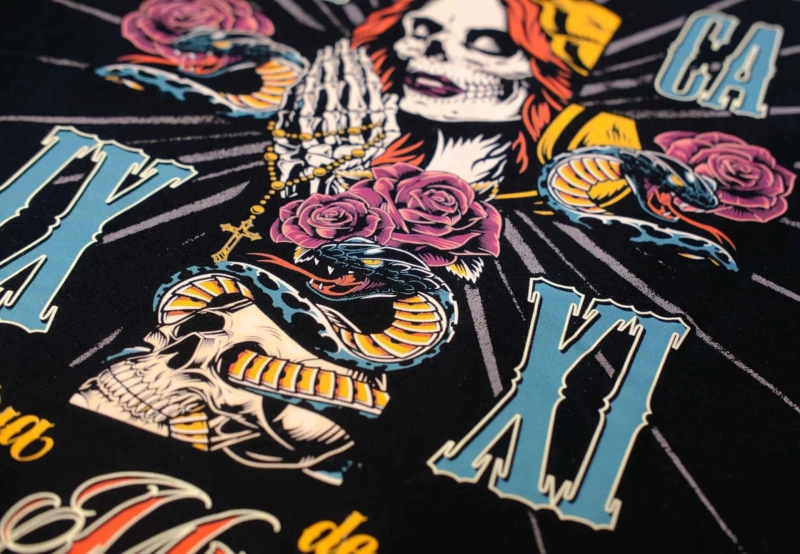The print on demand industry never ceases to amaze, offering innovative approaches for developing a private enterprise. A new direct-to-film (DTF) production type confidently competes with DTG printers" results, taking a part of the market share. In this article, we’ll take a closer look at these two methods of creating custom apparel and will figure out how to combine both options in one machine. So keep reading to learn DTF printing pros and cons and the main principles of organizing the working process.
DTF and DTG printing comparison
If you aim to develop a personalized manufacturing line, it would be helpful to determine which T-shirt printing techniques will better suit your goals. Both methods are widely used for custom item creation; still, their production and outcomes vary. So, let’s figure out the main factors to consider while choosing the right business direction.
Pre-treatment
Preparing the fabric before spraying the ink on its surface is a necessary step in the direct-to-garment method. This process helps cloths absorb ink better and avoids seeping into the fabric. Instead, DTF printing technology doesn’t require garment pre-treat because images are transferred to the film before taking their places on items. That’s why direct-to-film production is less time-consuming and saves human effort at this stage.
Fabric suitability
One of the main disadvantages of DTG vs. DTF printing is that the first one can be made only on cotton. This range includes combed organic variants and linen. As the ink is heat-pressed on the cloth surface, the image can’t be applied to any type of garment. Manufacturers can face fabric incompatibility while trying to settle paints on another material. This can cause unpleasant low-quality results.
In the case of DTF transfer printing, entrepreneurs can use a great variety of textiles because the designed film is perfectly fixed on the product with a heat-melting adhesive without losing saturation.
Quality
DTF images look shinier and brighter. The colors are pure and don’t interfere with each other. Customers can feel a thin layer of plastic and powder on direct-to-film clothes, while DTG printings are rougher and feel like the base fabric. Both ready-made garments have good washing performance. The industry standard for printed clothes is 50 washes. But how long does DTF printing last? Some say they can withstand 50-75 washing cycles, depending on the fabric, ink, storage conditions, etc.
Production volume
The direct-to-garment method allows the creation of more extensive customized output and is faster and more versatile. So, here comes one of the DTF printing cons: it is suitable for small amounts of stuff or may be implemented additionally to the main production line.
Eco-friendliness
The DTF method is less planet-saving than sustainable direct-to-garment (DTG) printing, and here is why. A lot of PET wastage occurs during the process of making films. Moreover, some uncertified adhesive powders can contain enormous levels of toxic substances that can harm health. DTG variant appears more eco-friendly because a chemical for painting textiles can be reused multiple times, reducing additional expenses.
Garment size
When comparing DTF printing vs. silk screen, we can surely say that the first method can cover any size of the cloth. The only thing needed is to cut a film to an appropriate scale. In the DTG method, suiting all the fabric sizes can also cause additional expenses because manufacturers will need to produce unique frames for each particular order.
If you found some benefits of direct-to-film manufacturing and want to implement it in your company, you should know how it functions first. Let’s deal with this task.
How does DTF printer work?
Special RIP software is used in the DTF printing package for managing colors, picture sizes, and other characteristics. All the designs are first transferred to the film and then to the garment.
PET layers are thin enough, and the main difference between DTF vs. screen printing lies here. A plastic layer usually has a 0.75 mm thickness and is intended for cold and hot transfers.
The foundation of every image is printed with white color, while the others form the entire picture above. DTF printers for shirts have several color ink tanks for Cyan, Yellow, Magenta, White and Black patterns, as usual. This palette allows reaching bright and realistic pictures.
When the design is transferred to the film, it is covered with adhesive powder (which can be previously melted by a curving oven). This material helps to bind the screen to the garment surface.
So, the heat machine fulfills the last stage of the process - this equipment transfers the colored image from the screen to the desired fabric. In the following chapters, we’ll discuss all the stages of direct-to-film production in more detail.
And here, we also want to pay attention to the most frequent question: what is the best DT2F printer? No one-fit-all solution exists because every business is unique and requires a unique approach. Here you can examine the top 30 possible variants in 2023 and select a budget for your successful enterprise.
Alternatively, you may also consider UV DTF printing; it doesn’t require all the described equipment. You’ll only need an ultraviolet flatbed and laminating devices. Then you can simply paste a sticker with an image on the material with your hands.
Prepping and setting up the DTF printer
It’s quite easy to set up a DTF printer for a startup and other equipment used in creating customized stuff. Here are some recommendations you should follow to get high-quality results:
- choose the 22” format size and resolution >320 DPI;
- change the color scheme to CMYK;
- make a separate transparent layer for details you don’t want to print;
- cure the powder in the oven for 10-12 minutes under 200 degrees;
- set up the heat machine at 375 degrees (or another one, according to the device instructions) and 12-15 seconds to transfer the image to the fabric.
These recommendations will help to achieve the best outputs, regardless of the DTF printer price. And now, let’s learn how the image on the fabric becomes radiant and realistic.
What the DTF powder process looks like
A hot-melt adhesive is the main component that makes the DTF printing process. The 80-200-micron granular powder is settled on the film ink while it is still wet. Then it goes through a curing cycle provided by a conveyer dryer, shaker, or heat equipment.
The powder can be applied manually. In this case, it’s important to consider good ventilation in the production area. It would be better to use Oeko-Tex-certified powder, which contains low levels of toxic compounds, safe for human health.
If you have the possibility to buy a DTF printer with a shaker, you’ll get an eco-friendly, cost and time-saving process of direct adhesive material application. The powder will be settled automatically; then, you’ll need to place a garment with a film into a heating device and get the printed product.
Why humidity and temperature matter
While organizing a print on demand business, keeping a suitable environment in the workspace is crucial. Thus, DTF printing machines operate at t=10-30°C. So to keep the average 20°C in the room, business owners should consider air conditioning in summer and heating in cold seasons.
If the temperature differs from the required range, it can cause changes in ink consistency. Paints will become more viscous and could bring damage to equipment. Then, how to do DTF printing correctly while considering such conditions? All the devices, including curing and heating machines, should be placed inside the production area, hidden from direct sunlight. For their stable and durable work, you should avoid rapid temperature changes, like opening doors or windows. However, the ventilating system should function perfectly to provide fresh air.
Humidity is another environmental factor that can affect the process. The ideal level counts 55% if you want to get a perfect result. Too dry air can impact the inks and pre-treatment liquid, worsening its quality and causing frequent cleaning cycles for equipment. Conversely, too wet air can damage even the best device for DTF printing and lead to additional expenses and delays in order fulfillment. If you keep fabric stocks in the same room, you should be aware that they absorb extra humidity. So to avoid low-quality outcomes, you’ll have to take steps to dry the textile beforehand...


